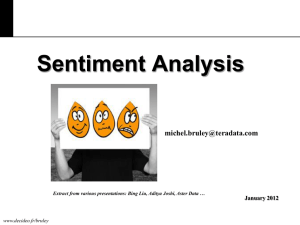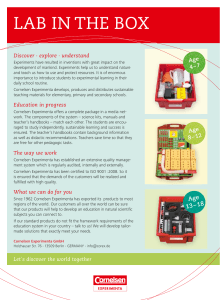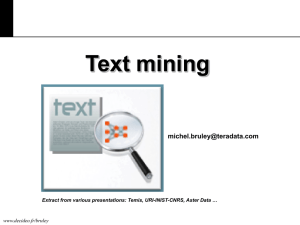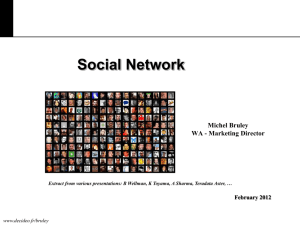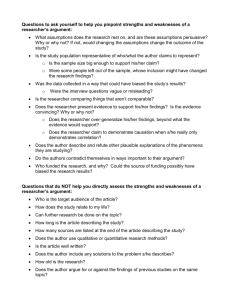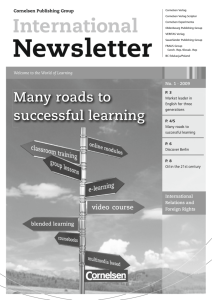Writing A Literature Review and Using a Synthesis Matrix
advertisement
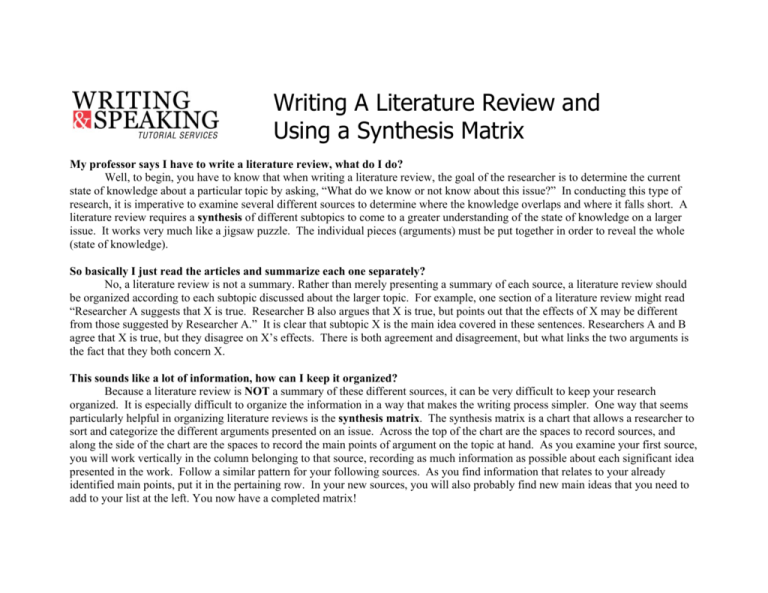
Writing A Literature Review and Using a Synthesis Matrix My professor says I have to write a literature review, what do I do? Well, to begin, you have to know that when writing a literature review, the goal of the researcher is to determine the current state of knowledge about a particular topic by asking, “What do we know or not know about this issue?” In conducting this type of research, it is imperative to examine several different sources to determine where the knowledge overlaps and where it falls short. A literature review requires a synthesis of different subtopics to come to a greater understanding of the state of knowledge on a larger issue. It works very much like a jigsaw puzzle. The individual pieces (arguments) must be put together in order to reveal the whole (state of knowledge). So basically I just read the articles and summarize each one separately? No, a literature review is not a summary. Rather than merely presenting a summary of each source, a literature review should be organized according to each subtopic discussed about the larger topic. For example, one section of a literature review might read “Researcher A suggests that X is true. Researcher B also argues that X is true, but points out that the effects of X may be different from those suggested by Researcher A.” It is clear that subtopic X is the main idea covered in these sentences. Researchers A and B agree that X is true, but they disagree on X’s effects. There is both agreement and disagreement, but what links the two arguments is the fact that they both concern X. This sounds like a lot of information, how can I keep it organized? Because a literature review is NOT a summary of these different sources, it can be very difficult to keep your research organized. It is especially difficult to organize the information in a way that makes the writing process simpler. One way that seems particularly helpful in organizing literature reviews is the synthesis matrix. The synthesis matrix is a chart that allows a researcher to sort and categorize the different arguments presented on an issue. Across the top of the chart are the spaces to record sources, and along the side of the chart are the spaces to record the main points of argument on the topic at hand. As you examine your first source, you will work vertically in the column belonging to that source, recording as much information as possible about each significant idea presented in the work. Follow a similar pattern for your following sources. As you find information that relates to your already identified main points, put it in the pertaining row. In your new sources, you will also probably find new main ideas that you need to add to your list at the left. You now have a completed matrix! 2 As you write your review, you will work horizontally in the row belonging to each point discussed. As you combine the information presented in each row, you will begin to see each section of your paper taking shape. Remember, some of the sources may not cover all of the main ideas listed on the left, but that can be useful also. The gaps on your chart could provide clues about the gaps in the current state of knowledge on your topic. CREATING YOUR SYNTHESIS MATRIX It is probably best to begin your chart by labeling the columns both horizontally and vertically. The sample chart below illustrates how to do this. Topic: ______________________________________ Source #1 Source #2 Source #3 Source #4 Main Idea A Main Idea B Label the columns across the top of your chart with the author’s last name or with a few keywords from the title of the work. Then label the sides of the chart with the main ideas that your sources discuss about your topic. As you read each source, make notes in the appropriate column about the information discussed in the work, as shown in the following chart. 3 Topic: Women in WWII Alteration of women’s roles because of WWII Hardships and oppositions women faced Cornelsen - Women accredited the WASP program for opening new doors, challenging stereotypes, and proving that women were as capable as men (p. 113) - Women could compete with men as equals in the sky because of their exemplary performance (p. 116) - WASP created opportunities for women that had never previously existed (p. 112) - Women’s success at flying aircrafts “marked a pivotal step towards breaking the existing gender barrier” (p. 112) - “From the outset male pilots resented women’s presence in a traditionally male military setting” (p. 1113-4) - “The WASP were routinely assigned inferior planes that were later found to have been improperly maintained” (p. 114) - discrimination against WASP at every level of military service, women were only paid 2/3 of what men were for doing identical tasks (p. 114) Stewart - WAAC (Women’s Army Auxiliary Corp) was 1st chance for women to serve in army, given full army status in 1943 as WAC (p. 28) - Needs of the war were so great that women’s traditional social roles were ignored (p. 30) - Military women paid well for the time period and given benefits if they became pregnant (p. 32) - The 1940’s brought more opportunities to women than ever before (p. 26) Bruley -Women given equal opportunities (p. 223) - Women joined workforce as a break from the ordinary to help the war (p. 220) - Unconscious decision to cross into male-dominated roles (p. 221) - Seized these new opportunities to bring about change (p. 230) - Women in the military given extensive physical and mental tests, but still discriminated against, ridiculed, and considered inferior to men (p. 29) - Women given unskilled labor positions by government because only seen as temporary workers, therefore no reason to train them (p. 221-2) - Women given less significant work and viewed as less intelligent and physically able (p. 224) -“The Church-Bliss diary reveals how dilution arrangements…ensured that women working in male preserves were prevented Scott - Women born in the 1920’s found new doors open to them where they once would have encountered brick walls (p. 526) -Even women not directly involved in the war were changing mentally by being challenged to expand their horizons because of the changing world around them (p. 562) - War also brought intellectual expansion to many people (p. 557) 4 Cornelsen - “In the belief that women were emotionally and physically fragile, the military questioned women’s capabilities to fly an aircraft” (p. 114-5), regardless of their training or aptitude - WASP’s not granted veteran status until 1979 (p. 115) Opposition: WWII did NOT effect women Stewart - Women put in untraditional roles during/because of the war, but back to previous subservient roles after the war (p. 35) Bruley from achieving any sort of equality” (p. 230) - more traditionally male jobs resisted the integration of women workers, while other industries were less resistant… but in most all cases women were considered temporary workers (p. 221) - Equal pay rarely given to women, even though women did the same work (p. 221) - Women occasionally found their way to positions of importance, but were always treated as inferior (p. 226-8) - After the war, women were the first to be let go because of their temporary status (p. 230) - Women in the workforce also faced discrimination from labor unions (p. 226) - Women were not affected because they still remained in subordinate positions after the war (p. 217) Scott After your chart is complete, notice patterns of information. You may find that your sources, at times, discuss very similar material, or that they sometimes deal with completely different aspects of your topic. These patterns can be useful in creating a thesis statement that can guide your writing and keep you focused as you begin your draft. 5 WRITING YOUR REVIEW Here is an example from the literature review: “World War Two and its Effect on Women.” This excerpt synthesizes information without summarizing. While the articles used in this research agree that women made many advances during the Word War II period, it is crucial to realize that not all these changes were welcomed. In most cases women faced discrimination from just about everyone around them. Women in the workplace were often placed in positions of inferiority or treated as being less physically able to do the same work the men did. Many women were often not trained because they were viewed as temporary employees who were only there for the duration of the war (Bruley, 2003, pp.221-222). Women were very rarely given equal pay as men, even though some of them did the same work. Women in the military faced not only mental abuse but also physical harm from their male counterparts. According to Cornelsen (2005), there were many instances where female aviators were injured or killed due to being made to fly ill-maintained aircrafts or aircrafts that had been sabotaged. (p.114) The sample above is an excellent example of how to synthesize information adequately. Notice how when transitioning from Bruley to Cornelsen the writer notes not only that the two articles are similar, but also how they are similar. The writer goes into detail about Bruley’s discussion of women in industry facing discrimination while noting that Stewart deals with prejudice in the military. The author also transitions well between the Bruley article and the Cornelsen article; rather than summarizing, the author draws comparisons between the two articles, giving relevant information and at the same time synthesizing the two works. _____________________________________________________________________________________________________________________ This document was created by NC State University Writing and Speaking Tutorial Service Tutors during Fall 2006. Contributors were Laura Ingram, James Hussey, Michelle Tigani, and Mary Hemmelgarn. Special thanks to Stephanie Huneycutt for providing the sample matrix and paragraph. http://www.ncsu.edu/tutorial_center/writespeak
